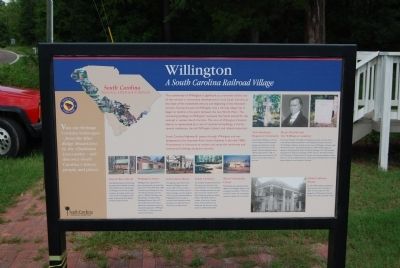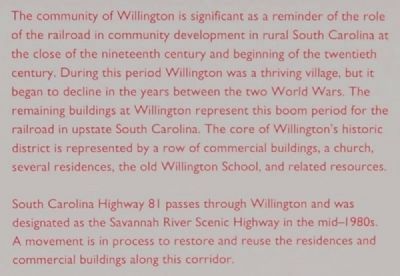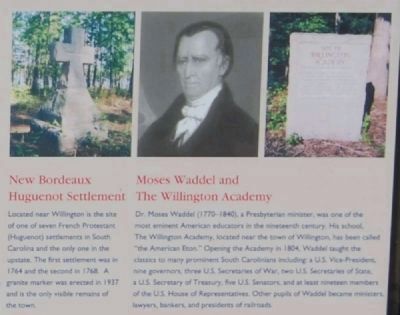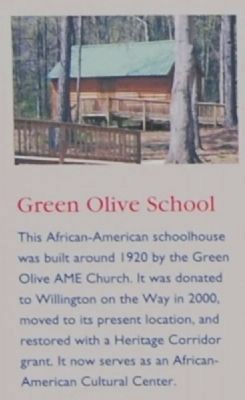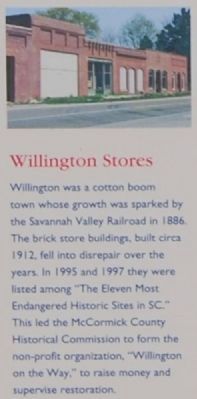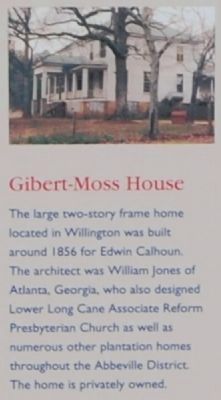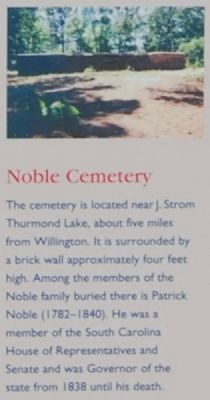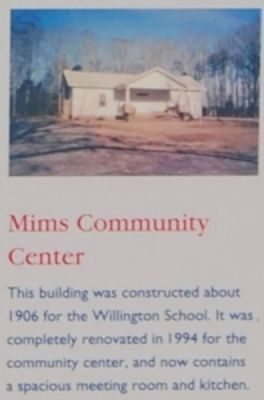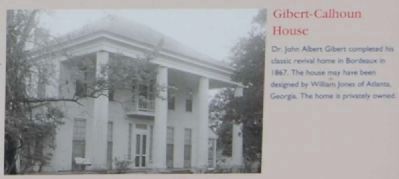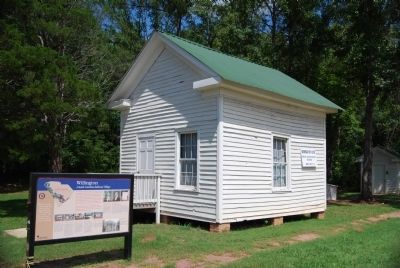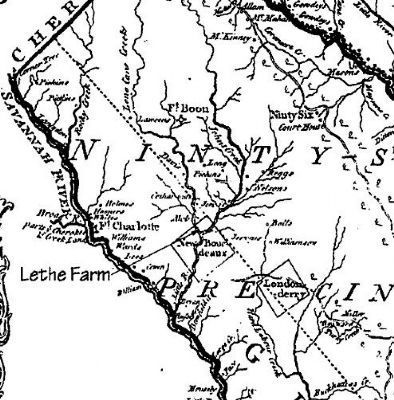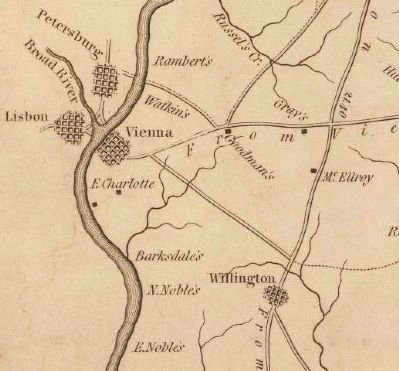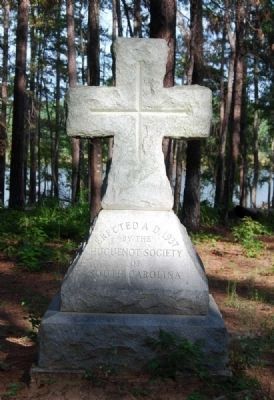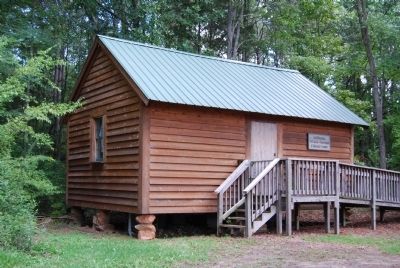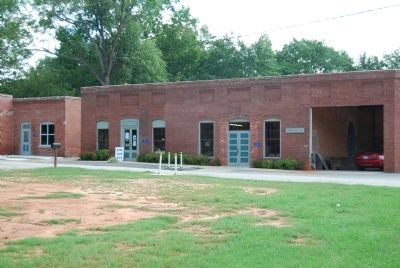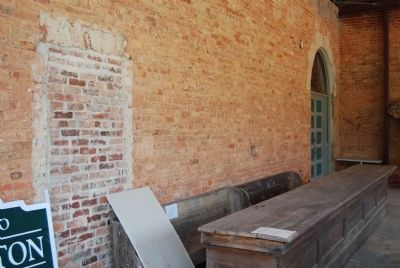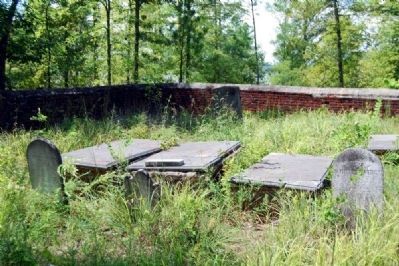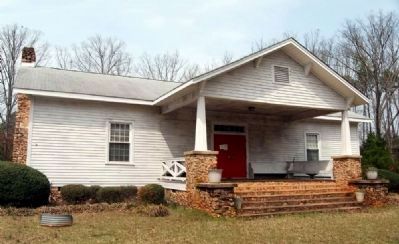Willington in McCormick County, South Carolina — The American South (South Atlantic)
Willington
A South Carolina Railroad Village
The community of Willington is significant as a reminder of the role of the railroad in community development in rural South Carolina at the close of the nineteenth century and beginning of the twentieth century. During this period Willington was a thriving village, but it began to decline in the years between the two World Wars. The remaining buildings at Willington represent this boom period for the railroad in upstate South Carolina. The core of Willington's historic district is represented by a row of commercial buildings, a church, several residences, the old Willington School, and related resources.
South Carolina Highway 81 passes through Willington and was designated as the Savannah River Scenic Highway in the mid-1980s. A movement is in process to restore and reuse the residences and commercial buildings along this corridor.
New Bordeaux Huguenot Settlement
Located near Willington is the site of one of seven French Protestants (Huguenot) settlements in South Carolina and the only one in the upstate. The first settlement was in 1764 and the second in 1768. A granite marker was erected in 1937 and is the only visible remains of the town.
Moses Waddel and The Willington Academy
Dr. Moses Waddel (1770-1840), a Presbyterian minister was one of the most eminent American educators in the nineteenth century. His school, The Willington Academy, located near the town of Willington, has been called "the American Eton." Opening the Academy in 1804, Waddel taught the classics to many prominent South Carolinians including a U.S. Vice President, nine governors, three U.S. Secretaries of War, two U.S. Secretaries of State, a U.S. Secretary of Treasury, five U.S. Senators, and at least nineteen members of the U.S. House of Representatives. Other pupils of Waddel became ministers, lawyers, bankers, and presidents of railroads.
Green Olive School
This African-American schoolhouse was built around 1920 by the Green Olive AME Church. It was donated to Willington on the Way on 2000, moved to its present location, and restored with a Heritage Corridor grant. It now serves as an African-American Cultural Center.
Willington Stores
Willington was a cotton boom town whose growth was sparked by the Savannah Valley Railroad in 1886. The brick store buildings, built circa 1912, fell into disrepair over the years. In 1995 and 1997 they were listed among "The Eleven Most Endangered Historic Sites in SC." This led the McCormick Historical Commission to form the non-profit organization, "Willington on the Way," to raise money and supervise restoration.
Gibert-Moss House
The large two-story frame home located in Willington was built around 1856 for Edwin Calhoun. The architect was William Jones of Atlanta, Georgia, who also designed Lower Long Cane Associate Reformed Presbyterian Church as well as numerous other plantation homes throughout the Abbeville District. The home is privately owned.
Noble Cemetery
The cemetery is located near J. Strom Thurmond Lake, about five miles from Willington. It is surrounded by a brick wall approximately four feet high. Among the members of the Noble family buried there is Patrick Noble (1782-1840). He was a member of the South Carolina House of Representatives and Senate and was Governor of the state from 1838 until his death.
Mims Community Center
This building was constructed about 1906 for the Willington School. It was completely renovated in 1994 for the community center, and now contains a spacious meeting room and kitchen.
Gibert-Calhoun House
Dr. John Albert Gilbert completed his classic revival home in Bordeaux in 1867. The house may have been designed by William Jones of Atlanta, Georgia. The home is privately owned.
Erected by South Carolina Heritage Corridor.
Topics and series. This historical marker is listed in these topic lists: Notable Places • Railroads & Streetcars
• Settlements & Settlers. In addition, it is included in the African Methodist Episcopal (AME) Church, and the South Carolina Heritage Corridor series lists. A significant historical year for this entry is 1764.
Location. 33° 58.317′ N, 82° 28.033′ W. Marker is in Willington, South Carolina, in McCormick County. Marker is on SC Highway 81, on the right when traveling north. Marker located near the restored Post Office. Touch for map. Marker is in this post office area: Mc Cormick SC 29835, United States of America. Touch for directions.
Other nearby markers. At least 10 other markers are within 3 miles of this marker, measured as the crow flies. Willington Academy (within shouting distance of this marker); Cherry Hill / Noble Cemetery (within shouting distance of this marker); Site of Willington Presbyterian Church (approx. 1.1 miles away); Site of Willington Academy (approx. 1.2 miles away); Guillebeau Home and Family Cemetery (approx. 2.1 miles away); Andre Guillebeau (approx. 2.3 miles away); John De La Howe School Enterprise Market Program at "The Barn" (approx. 2.7 miles away); John De La Howe School (approx. 2.7 miles away); John De La Howe / John De La Howe School (approx. 2.8 miles away); De La Howe Hall (approx. 3 miles away). Touch for a list and map of all markers in Willington.
Also see . . . Willington, South Carolina. Willington is a census-designated place (CDP) in McCormick County, South Carolina, United States. (Submitted on November 28, 2009, by Brian Scott of Anderson, South Carolina.)
Additional commentary.
1. Facts About Willington
* The Bookshop holds nearly 15,000 "like new" books.
* The History Center is the only repository for historical records and artifacts in McCormick County.
* The Gift Shop sells works by local artists.
* The Taste of Thai Cafe serves authentic Thai cuisine.
* The African-American Culture Center includes a library and exhibits.
* The Mims Community Center regularly holds programs and includes a meeting room.
All are open Wednesday - Saturday from 11:00 am - 3:00 pm. The Thai Cafe closes at 2:30 each day. (Source: Bruchure published by Willington On the Way)
— Submitted September 14, 2008, by Brian Scott of Anderson, South Carolina.
2. My Thoughts on Willington
If you are ever on SC Highway 81 and happen to come upon Willington, do yourself a favor and stop. If open, checkout the Historic Center. There one of the members of Willington on the Way will help you in learning about this once thriving community. Artifacts include a brandy still, ledgers, books, and photographs. While few of the buildings remain and the town population is barely over 100, the spirit of enterprise is here. Unlike most communities who are restoring themselves, Willington not only has to restore what is present, but to rebuild what is needed. I have no doubt they will succeed.
— Submitted September 14, 2008, by Brian Scott of Anderson, South Carolina.
3. New Bordeaux
The town of New Bordeaux was planned and built in the design typical of a French village, the site on a gently rolling plane. Log homes were built on half acre lots in neat rows along narrow streets. On the home lots the Huguenot refugees planted fruit trees. Even now in springtime, the site reveals garlands of white blossoms of plum trees relevant to those French colonists of more than two centuries ago.
The village was an integral, self-sustaining community. For within the village there were the pastor, schoolteachers, and a medical doctor. There were skilled craftsmen: tailors, seamstresses, shoemaker, clog-maker, cabinet maker, coopers, wheelwrights, masons, carpenters, joiners, boatmen, vine dressers, and blacksmiths. Certainly all played a vital role in the welfare of the village. It should be emphasized that these Huguenots were some of France's finest professionals. Their professions, however, did not prevent these artisans from keeping their gardens and farm animals, and many pursued agricultural vocations. They all did any occupations in demand for that was, indeed, how they survived an prospered.
North of the village, on the southwest and southeast sides of Little River were the family, four-acre vineyard lots stretching along gentle slops toward the river. on these mini-farms the Huguenots developed grape vineyards. On the same lots they cultivated garden crops such as maize (Indian corn), potatoes, beans, and cabbage. And there were fruit trees scattered among the grape vineyards.
The saltus lands, that is the uncultivated lands, mostly forested in natural vegetation, surrounding the village in great abundance. These lands they used for grazing their cattle, sheep, horses, goats and hogs. And to the villagers these natural areas yielded a bonanza of resources such as fire wood, wild honey, berries, nuts, and any number of herbs for the cooking pot -- dandelion, asparagus, and plenty of garlic. The saltus lands were replete with wild game, and the streams with fish.
In New Bordeaux the Huguenots immediately organized a local form of government. The village governing council consisted of five members, the justice of peace, the minister, and the three officers of the village militia. It appears to have been a sort of branch of the provincial government in Charles Town with the local council directing reports to the colonial assembly. The Justice of the Peace was supplied with a copy of Simpson's Justices' Guide. The militia was an active and trained unit that served as a defense against Indian attacks, and during the American Revolution it served 100% as a patriot fighting force.
The first recorded marriage at New Bordeaux was that of Pierre Moragne, son of Pierre Moragne and Marie Paris, and Cecille Bayle, daughter of Jean Bayle and Marie Seyral, on July 16, 1765, "after the publication of three banns." They were married by "Monsieur Boutiton, Minister of the Gospel," with Pierre Bellot and son Helie Bellot, and other persons of New Bordeaux as witnesses. (Source: The Making of McCormick County by Bobby F. Edmonds (1999), pgs 69-71.)
— Submitted December 9, 2009, by Brian Scott of Anderson, South Carolina.
4. Willington Academy
The Willington Academy, which had been first established by Dr. Waddell at Vienna, in Carolina, a short distance from its subsequent site, has been described by one who was familiar with it, as having become famous all over the South. Says this writer:
After Dr. Waddell was forced from age and disability, to give up teaching, the school was revived by his sons, James and John Waddell, but under the general supervision of the old schoolmaster. No doubt his sons followed their father's plan of teaching, and as I was, when a boy, long an inmate of Moses Waddell's family, and a pupil at the Willington Academy, it may not be unentertaining to give a short account of the old Willington schoolhouse, as we had it from tradition. The boys boarded at farmhouses in the neighborhood or lived in log huts in the woods near the Academy, furnishing their own supplies. At sunrise Dr. Waddell was wont to wind his horn, which was immediately answered by horns in all directions. At an early hour the pupils made their appearance at the log cabin schoolhouse. The Doctor, entering the cabin and depositing his hat, would reappear at the door with this school horn in his hand. He then would call out loud, "What boy feels most flatulent this morning?"
After the horn had been sounded by some lucky youth, the school-boys came in to listen to a short set form of prayer.
After prayers the pupils, each with a chair bearing his name sculpted in the back of it, retired to the woods for study, the classes being divided into squads according to individual preference. In the spring and summer months these squads scattered through the oak and hickory woods in quest of shade; but in cold weather the first thing done by them was to kindle log-heap fires. Whosoever imagines that the boys did not study as well as they would have done under the immediate eye of the teacher is mistaken. I have been to many schools conducted according to various systems of education, but nowhere have I seen such assiduity in study, nowhere have I ever witnessed such emulation to excel. It was a classical school. The multiplicity of studies now advertised at fashionable academies was unknown in those early times. The debating club on Friday afternoons was an important institution, and regarded by the teacher as a very necessary part of his scholastic system, for to converse and speak in public were esteemed necessary accomplishments to Southern youths.
Of the famous schoolmaster, whose sons succeeded him in the school where the methods of their father's system were still continued in Curry's day at Willington, Mr. Calhoun long afterwards wrote as follows:—
In that character (as a teacher) he stands almost unrivaled. He may be justly considered as the father of classical education in the upper country of South Carolina and Georgia. His excellence in that character depended not so much on extensive or profound learning as a felicitous combination of qualities for the government of boys and communicating to them what he knew. He was particularly successful in exciting emulation amongst them, and in obtaining the good will of all except the worthless. The best evidence of his high qualities as a teacher is his success. Among his pupils are to be found a large portion of the eminent men in this state and Georgia. In this state it is sufficient to name McDuffie, Legare, Petigru, and my colleague, Butler. To these many others of distinction might be added. His pupils in Georgia who have distinguished themselves are numerous. In the list are to be found the names of William H. Crawford, Longstreet, etc. It is in his character of a teacher, especially, that he will long be remembered as a benefactor of the country.
During the year of Curry's stay at Willington an event of great importance in the eyes of the pupils was the visit to the school of the famous Siamese twins, Chang and Eng, who were then making their first tour in America. He makes record among his memoranda of seeing the twins at Willington. They seemed, he says, to be about seventeen years old; and cheerful and very agile.
"Cherry Hill," the home of George McDuffie, was near the Willington Academy; and was a favorite resort of the boys on Saturdays. McDuffie's distinguished career in the United States House of Representatives ended during the year of Curry's pupilage at Willington; and in the same year he was elected Governor of South Carolina. In 1842 he was chosen to the Senate, and was in the forefront of the forensic and political debates and contests of the period in that body.
It remains to be added, in connection with Curry's life at Willington, that both the sons of Moses Waddell, James Pleasants Waddell and John Newton Waddell, became eminent in their chosen profession as educators,—the former filling with success and distinction the chairs of Latin and Greek in the University of Georgia, where Curry records of him that he treated his old pupil with a fatherly care and kindness during the latter's career as a student; while John Newton Waddell became professor of Latin and Greek in the University of Mississippi, and later its Chancellor. (Source: J.L.M. Curry: a Biography by Edwin Anderson Alderman and Armistead Churchill Gordon (1911), pgs 22-25.)
— Submitted December 9, 2009, by Brian Scott of Anderson, South Carolina.
5. Moses Waddel and the Willington Academy in South Carolina
One morning in the late autumn of the year 1794, a Presbyterian preacher left the Georgia side of the Savannah River and crossed over to South Carolina. He was of low stature and had a boyish face, for he was only twenty-four years of age. He rode to a schoolhouse that stood in the Calhoun Settlement, on Long Cane Creek, in Abbeville District, and found assembled there a company of Scotch-Irish people. When he arose to speak, the congregation was surprised to hear a deep-toned, musical voice. The preacher's calm, gray eyes looked straight into their eyes and his earnest, rapid talking caught their attention. When the sermon was ended, Patrick Calhoun, patriarch of the community and elder in the neighboring church, led the minister to his home. While they were seated, that evening, around the wide, old-fashioned fire-place in the Calhoun home, the door was opened and a youthful face looked in, but was at once withdrawn. The face belonged to John Caldwell Calhoun, Patrick Calhoun's son, who afterwards became South Carolina's great statesman. A year later, the young minister, whose name was Moses Waddel, married Catharine Calhoun, sister of John C. Calhoun, and took her to his home beyond the Savannah. There, in Georgia, Waddel was preaching the gospel and teaching Latin and Greek to a group of schoolboys.
Moses Waddel was born (1770) in Iredell County, North Carolina. His parents were Scots from North Ireland. Soon after Moses completed his eighth year he went to James Hall's school and began to study Latin. After six years of work, he finished the courses of study in Greek, Latin and mathematics, as far as these subjects were taught in the school. Then he took charge of various schools in North Carolina and Georgia until the year 1789, when he gave his heart to Christ. After a long struggle within his own breast, young Waddel determined to become a preacher. In the autumn of 1790, therefore, he mounted his horse and made the long journey from Georgia to Virginia. In the month of September in that year he began a course of study at Hampden Sidney College. A little more than a year later he left the college, and in May, 1772, was licensed by Hanover Presbytery to preach the gospel. The year 1794 found him established as pastor of Carmel Church, south of the Savannah. At the same time he organized a school in Columbia County, Georgia. Near the close of that year he crossed the Savannah, as we have seen, and there met Catharine Calhoun, who became his wife and his helper in the Georgia school. In 1801 Waddel moved his home to Abbeville District, South Carolina, and there opened his school in the village of Vienna. A little later, however, he selected a site upon a ridge near the Calhoun Settlement. There, among oak and hickory trees, he erected a log house and called it Willington Academy. Log cabins for the students were put up near the main building. For a long period of time, as many as one hundred and eighty students came each year to receive instruction from this wonderful teacher, Moses Waddel.
The food furnished to the students
in Waddel's log college was plain, for it was usually nothing more than cornbread and bacon. A blast from a ram's horn called them all together for morning and evening prayers. When the weather was mild the students sat or lay beneath the trees to prepare their lessons. The sound of the horn told the class in Homer when to assemble, and all of the members of it rushed at once to the recitation hall in the main building. Then the horn called up, in regular order, the Cicero, the Horace and the Virgil classes, as well as those engaged in the study of mathematics and English.
Waddel had a clear mind and a strong will. He gave his pupils an admirable training in all of their studies. Moreover, he held them under his own absolute control through strict discipline. The master loved each pupil. He governed them with love and with impartial justice.
A large company of ministers received their entire training in Waddel's school. Of these we may name Richard B. Cater, John H. Gray, David Humphreys, James Gamble, James C. Patterson and Thomas D. Baird. Some famous scholars and statesmen also were educated in this log college, among whom were William H. Crawford, Howell Cobb and A. B. Longstreet, of Georgia, and John C. Calhoun, Hugh S. Legare, James L. Petigru, George McDuffie, and many others, of South Carolina.
The Willington school building was also a church. Waddel preached every Sunday to his students and to the people of the community. In 1809 these worshippers were regularly organized as a Presbyterian Church. A revival of religion took place there and many of the students became Christians.
During a period of about fifteen years Moses Waddel kept up at Willington the best school in all that part of our country. In 1819 he went to Athens, Georgia, to take charge of the University of Georgia as President. He was then the most famous teacher in the far South, and he at once placed this school upon a high plane of literary excellence. He preached the gospel every Sunday to the body of students assembled in the chapel. He conducted the university as a Christian school throughout his presidency of ten years. At the close of the year 1829 he gave up the heavy work at the university and went back to Willington. The academy was opened there again under the control of Waddel's son. The old preacher himself spent nearly all of his closing days in giving to the people of that region the gospel of peace. He died in 1840. (Source: Southern Presbyterian Leaders by Henry Alexander White (1911), pgs 199-202.)
— Submitted December 9, 2009, by Brian Scott of Anderson, South Carolina.
Credits. This page was last revised on September 17, 2020. It was originally submitted on September 14, 2008, by Brian Scott of Anderson, South Carolina. This page has been viewed 2,545 times since then and 78 times this year. Photos: 1. submitted on September 14, 2008, by Brian Scott of Anderson, South Carolina. 2, 3, 4, 5, 6, 7, 8, 9. submitted on November 28, 2009, by Brian Scott of Anderson, South Carolina. 10. submitted on September 14, 2008, by Brian Scott of Anderson, South Carolina. 11. submitted on November 23, 2009, by Brian Scott of Anderson, South Carolina. 12. submitted on December 6, 2009, by Brian Scott of Anderson, South Carolina. 13. submitted on April 13, 2011, by Brian Scott of Anderson, South Carolina. 14, 15. submitted on September 14, 2008, by Brian Scott of Anderson, South Carolina. 16. submitted on July 20, 2008, by Brian Scott of Anderson, South Carolina. 17. submitted on September 14, 2008, by Brian Scott of Anderson, South Carolina. 18, 19. submitted on April 13, 2011, by Brian Scott of Anderson, South Carolina.
